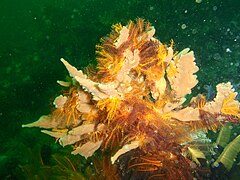The dive site Glencairn Fan Garden is an offshore rocky reef in the Glencairn area on the Cape Peninsula, near Cape Town in the Western Cape province of South Africa.
Understand
[edit]
This site is known for the large numbers of gorgonian sea fans in relatively shallow water
Position
[edit]- 1 Glencairn Fan Garden: S34°09.418' E018°26.412' — (approximate)
This site is in the Table Mountain National Park Marine Protected Area since 2004. A permit is required.
Name
[edit]
The name "Glencairn Fan Garden" is derived from the location off Glencairn, and the large numbers of gorgonian sea fans found there.
Depth
[edit]Maximum depth is about 14 m, and the top of the ridges are about 9 m. Average depth is likely to be about 10 to 11 m.
Visibility
[edit]Visibility is likely to be moderate, around 5 to 6 m, but may be less, and on a good day may be more than 10 m.
Topography
[edit]The reef is generally low profile, flattish bedrock, with a few smallish boulders, and some sandy areas on the southern and eastern edges. There are some low ridges with dip and strike similar to the rock on the shoreline.
Geology: Ordivician sandstone of the Table Mountain group. Probably Peninsula formation, or the underlying Graafwater formation. Strike is east/west, and the dip is shallow (about 10°) and to the south.
Conditions
[edit]The site is exposed to south easterly wind and waves. It is reasonably sheltered from short period south westerly swell, and the site is usually at it's best in winter, but there are also occasional opportunities during autumn and spring. Some surge is to be expected. The site may be diveable when more popular sites to the south side of Simon’s Town are too rough.
Get in
[edit]Usual access is by boat, but it would be possible to dive from a shore entry with a long swim of about 350 m each way.
The site is about 4 km from Simon's Town jetty, or 8.9 km from Miller's Point slipway.
See
[edit]Marine life
[edit]Reef cover is typical for this area, and is dominated by echinoderms, but there are also a large number of sea fans of three species. By far the most common are the Palmate sea fan,Leptogorgia palma, but there are also a fair number of Sinuous sea fan and Flagellar sea fan (also known as Whip fan). The fans are often infested with epibiota, such as crabs, bryozoans, ascidians, catshark eggs and brittle stars.
- Palmate sea fan Leptogorgia palma with Elegant feather star Tropiometra carinata
- Sinuous sea fan Eunicella tricoronata
- Flagellar sea fan or Whip fan, Eunicella albicans
- Encrusting sponges
- Sponge and common feather stars
- Colonial sea squirts and brittle stars
- Sponges and feather stars
Photography
[edit]Suitable for macro and wide angle photography.
Suggested Routes
[edit]No specific routes recommended.
Stay safe
[edit]Hazards
[edit]This area is known to be frequented by great white sharks in summer. There are no reports of sightings by divers, but they have been seen from the air.
Skills
[edit]No special skills required, the site is suitable for entry level divers.
Equipment
[edit]No special equipment required. A DSMB is recommended if you plan to go far from the shotline, as this will help the boat crew to spot you when you surface.
Nearby
[edit]- 1 Kalk Bay Harbour Wall
- 2 Fish Hoek Reef
- 3 Sunny Cove
- 4 Quarry
- 5 Quarry Barge
- 6 P87
- 7 SS Clan Stuart
- 8 Brunswick
- 9 HNMS Bato
Back to the Alphabetical list of sites, or list of dive sites in the Fish Hoek and Glencairn area
Other regional dive sites:
- Dive sites of Table Bay and approaches,
- Dive sites of the Cape Peninsula west coast
- Dive sites of False Bay offshore and approaches
- Dive sites of False Bay east coast
- Fresh water dive sites of the Cape Town Metropolitan Area









